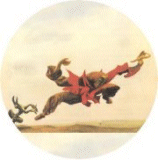
Contents ||| Study Tools |||
Classical Literature ||| Contact |||
Blog
Mel Gibson's movie The Man Without a Face, Selected and introduced for ELLOPOS by Nat Gerrs
Page 3
JUSTIN McLEOD was a teacher who now worked as an artist. They had sentenced him to a three years imprisonment and canceled his licence to teach, after a car crash, in which Patrick, a close friend and pupil of his, burned to death. He is disfigured - with a "hamburger head", as Norstadt described him in one of his moments of anger. He could resort to plastic surgery, but that "just never seemed right", as he says.
Where a face sometime was, he has now accepted a mask. He sees in himself a fary-tale troll for people's entertainment. His life has become a part of a play, and a sad one, which he plays patiently, escaping only in artistic reflection. "What about living alone, do you like that?", - "It likes me", he answers. Properly speaking, McLeod is not a man without face, he is a man with a mask, he is a man with a role to play and he is also a man without a face and also a man who had a face sometime.
Both McLeod and Norstadt live not beyond, but at the margin of the crowd and in the crowd, to the degree that they submit to an identity - e.g. "the hermit and the rebel", "the beast and the fool" - think more... But we see only McLeod as a man with a mask, and not both of them, because Norstadt has brought forth a need for a face.
Cf. Someone Like Hodder | Rilke, Letter to a young poet | Jaspers, Truth is in communication | J. O. y Gassett, The Revolt of the Masses | Tom Schulman, Dead Poets Society | Wordsworth's and Magee's poems | K. Mansfield, There was a child once
More by Nat Gerrs : Why Europe? | J. M. Lefévre, The White Thinking